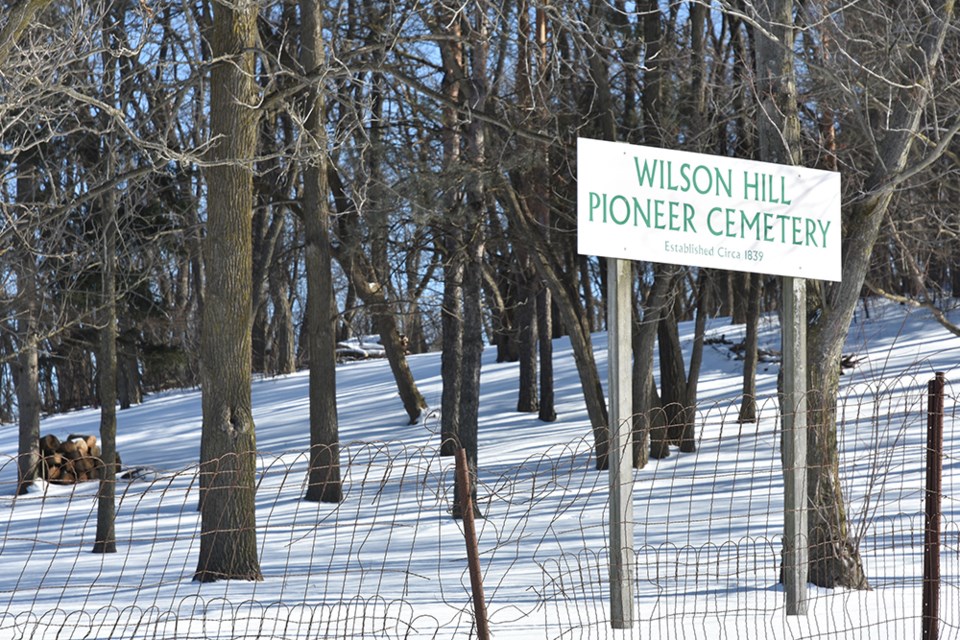Preserving, restoring and investigating the Wilson’s Hill Pioneer Cemetery has been a labour of love for Tracey Melidy, Vaughan Harris and Louis Theriault.
The trio have become the protectors and investigators of the cemetery, located at Line 12 and County Road 27, since 2017, extending the work of local residents like Neil McBride.
Melidy was guest speaker at the Feb. 16 meeting of the BWG Local History Association, on the topic, “Puzzles of Wilson’s Hill Pioneer Cemetery.” Jan Blommaert introduced the speaker, noting, “Digging in the dirt, fixing things up – she got curious about the people buried in there.”
The first puzzle, said Melidy, is the name: Is it Wilson Hill, as it reads on one sign posted on the property, or Wilson’s Hill, as posted in another?
The land was deeded in 1858 as a cemetery by the United Presbyterian Church, although the first recorded burial was in 1839. It is a unique cemetery, located on a hilltop.
“The monuments are on the hill,” said Melidy, but they were overgrown by brush and trees, many markers broken and hidden, when the trio first began their restoration project.
As they began clearing the brush, and checking for grave markers, a second puzzle arose.
“Who is buried here? This is my favourite question,” said Melidy. “We don’t even know how many people are buried here.”
Estimates suggest the cemetery is the resting place of between 300 and 500 people, but without written records, the only way of knowing is to uncover the markers and trace the names.
Two of the earliest settlers in the area were the Dinwoody and Duff families, but there are plenty of other noteworthy monuments. One marks the burial site of Marguerite McBride Kirk.
McBride Kirk drowned in 1882, when the steamship Asia foundered on Georgian Bay.
“Overloaded, over-crowded and top heavy, they went out in a gale warning, and they did not come back,” said Melidy. There were only two survivors.
The Harper family has a plot in the cemetery. Henry Harper was a “pioneer merchant in Cookstown,” Melidy said, but it was his son Bert who was best known. A journalist and politician, he was a close friend of William Lyon Mackenzie King, who went on to become the 10th Prime Minister of Canada.
Bert Harper died in 1901, while skating on the Ottawa River with two friends. The ice cracked and the friends fell into the frigid water; Harper jumped in to try to save one, but both drowned before help could arrive.
King raised the funds to put up a statue in Ottawa representing Sir Galahad in Harper’s memory.
The markers at Wilson’s Hill also testify to the impact of epidemics, and the harshness of pioneer life, especially for children.
“There are at least 58 children under five years of age buried here,” said Melidy.
Tracing the burials and the records is made more difficult by the condition of some of the stones. Broken, worn, often the information is fragmentary. One such stone provides a date and age – June 20, 1867, four years of age – but no name.
Melidy, Harris and Theriault have spent hours clearing trees and brush, and “finding stones” – a total of 669 hours to-date “and we’re not done. Not even close,” she said.
They also discovered piles of the iron railings that once surrounded plots in the cemetery, and, where possible, have put the rails, corner posts and decorative chains back in place. They discovered another puzzle in doing so: at least three of the plots have a cap of concrete for some unknown reason.
Putting everything together has been “like a jigsaw,” said Melidy, but one puzzle was easily solved: “How did they get the monuments up the hill?”
Currently, it would be a challenge, but back in the days when Wilson’s Hill was an active cemetery, “Highway 27 followed the contour of the land a little better,” she said, and the entrance, off 27, would have been close to the top of the hill.
Most of the damage at the cemetery has been caused by two “vandals” – Mother Nature, and Father Time. High winds have brought down trees, damaging stones, and the weather and time have erased inscriptions and rotted the wooden signs put up by Neil McBride.
The signs have now been restored and replaced, and the visitors’ book kept at the site, protected.
“In the 1980s, Wilson’s Hill was the most visited cemetery in Simcoe County,” said Melidy, with visitors coming from as far away as Newfoundland, British Columbia, and the UK, to carry out genealogical research, among the inscriptions and the monuments, with their Victorian imagery and poetry.
Wilson’s Hill remains unique, “not only for the people who were buried there and for the local pioneers,” but for the artwork and the historical connections.
The earliest known interment was in 1839, the last circa 1958. And that is the final puzzle, said Melidy.
“We may never figure out who’s buried there.”
Guest speaker at the March 16 meeting of the BWG Local History Association will be Jan Coward, on the nurse sisters of the First World War, from the South Simcoe area. Anyone with family records of these nurses who provided aid to wounded soldiers is especially invited to attend and share their family history. Meetings are held at the BWG Public Library.



